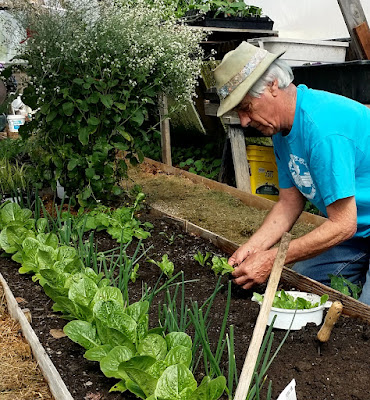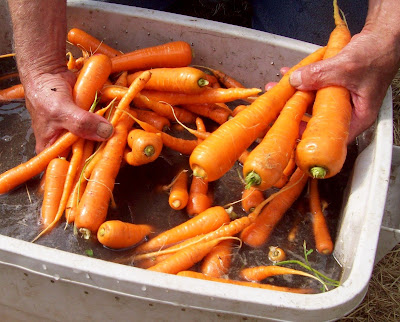 |
| Jim and Cindy with Kidney beans. |
Here's the process we use for processing Scarlet Runner Beans:
A unique and viable approach to establishing local food self-reliance and building stronger communities.
 |
| Jim and Cindy with Kidney beans. |
Here's the process we use for processing Scarlet Runner Beans:
This post has photo-highlights from the past month and LINKS to many timely Posts (below).
Hello everyone, being a gardener helps one tune into weather-changes and the rhythms of the seasons on a much more acute level. The Pacific NW, where we live has been experiencing the profound and ongoing effects of a La Nina year. For us, this means cooler temps and lots more rain. And, while we're grateful that we're not experiencing the record-breaking heat waves of Summer-2021 (our local thermometer reached 109 F at the end of June!) - having SO much rain presents its own challenges. We've had several perennial plants die as their roots drowned (forsythia, lilac and Gogi berries). Grass is growing like crazy, which is wonderful for mulching but sometimes the grass grows so fast between mowings that we have to cut it without bagging it and come back later to collect the clippings when they've dried out a bit, otherwise they just clog the mower. And, having to run the mower twice over the same ground to cut and bag the grass uses twice as much gas!
We are so very grateful for our greenhouses which have allowed us to plant and harvest significant quantities of beets, lettuce, carrots and other cool-weather crops, in spite of the rains outside. All the plants are looking marvelous! The next ten days show a warming trend with little rain so everything planted outside should really begin to grow with summer-vigor!
Garden Gallery:
The majority of our harvests are feeding our wonderful share-givers (volunteers) and ourselves and being donated to the Stone Soup Kitchen in Corvallis that prepares and serves/distributes 300-400 meals per month. We're donating much less to the South Benton Food Pantry this year for two reasons. One is that we've cut back on how much food we're growing and secondly, the Pantry is now blessed to be receiving donations from many new sources that weren't in place when we started our charity in 2009. Local growers contribute their surplus, and the warehouse serving the Pantry (Linn/Benton Food Share) is contracting with local farmers to grow produce too. We are happy to see how much more produce the Pantry is serving, and how much more interest the participants have in receiving it.
Garden's Progress: We don't have a lot of great pictures from this past month. When skies are overcast, and share-givers are bundled in sweatshirts and rain coats, it doesn't create a very photogenic scene! But here are a few pics to give you an idea of what we've been up to:
 |
| Llyn, in the rain, spreading straw for the cucumber patch. |
 |
| Here's Chris making piles of coffee grounds and wood-ash in preparation for our 20 cucumber plants. |
 |
| And here's Chris distributing compost and ashes for our corn patch. |
 |
| That bright green patch in the center is all carrot plants. We estimate that it yielded over forty pounds! |
 |
| Suzanne, loading buckets of wood chips to spread around our orchard-trees to minimize weeds and keep the moisture constant through the summer. |
 |
| Now, doesn't that look nice! |
 M.R. Tree is still bringing wood-chips as fast as our neighbors can haul them away for mulching projects of their own. Come and get 'em!
M.R. Tree is still bringing wood-chips as fast as our neighbors can haul them away for mulching projects of their own. Come and get 'em!
 |
| Come and get 'em! |
 |
| Chris, transplanting lettuce seedlings. |
 |
| Cindy, in the carrot patch |
 |
| Lua, unloading leaf mold (donated by Sunbow Farms/Harry McCormack). |
 |
| ...and the truck-load of 'starts' we sent back with her for her students. |
LINKS to Timely Posts:
Originally published early in the pandemic, this post continues to be relevant for those who are attempting to grow more of their own food. Locally Sustainable Gardening in the Face of Supply-Chain Shortages.
 |
| Beautiful, sweet, nutrient-dense carrots from this year. |
Here is a recipe that we've developed for Delicious Tofu Crumble: a great, plant-based alternative to ground beef or sausage in recipes such as chili, or as a pizza, or salad topping. Enjoy!
 |
| Tofu Crumble makes a wonderful plant-based pizza topping. |
Grow Your Own Protein - Scarlet Runner Beans: For several years, Chris and I have been able to grow a year's worth of beans for us, and have enough surplus to share with others in our gardening community.
How to build a Bean Tipi/Teepee...and grow beans for winter-storage
By purchasing a heavy-duty grain mill several years ago, we've been able to grow enough corn (both blue and yellow) and two kids of sorghum that we dry and grind and use in baked goods and in a nutritious, hot breakfast cereal. Grow Your Own 'Blue Corn'One beautiful side benefit of a rainy spring are some beautiful skies at sunset when the sun just peeks through from the west:
 |
| Sunset at the Sharing Gardens, May 2022. |
Are Nutrient Deficiencies Ruining Your Garden? By Amy Allen
Our one caveat to the linked Post is that, under the heading: 'What are the solutions to phosphorous deficiency', the author recommends the use of horse manure. We have had very bad experiences with using uncomposted horse manure in our gardens and had a whole season of tomato and pepper plants we were germinating from seed, be wiped out before discovering the source of contamination (we were using the horse manure in our potting mix). Unless you can be sure the manure has composted for 3-5 years, test the use of it in a small area of your garden before spreading it widely.
Here are the posts we wrote about herbicide contamination from horse manure: (pic left: herbicide contamination of tomato plant).Herbicide Contamination Update
The best mineral additive we've found is wood ash from a clean source (no paints, pressure-treatments etc). Wood ash provides all the minerals plants need with the exception of nitrogen and sulpher. Here's a Post we wrote about using wood ash for soil fertility: Coffee Grounds and Wood Ash for Soil Fertility
Hello local folks,
The Sharing Gardens, in partnership with Oregon State University, and the cooperation of the United Methodist Church (who we share our parking lot with) is offering free well-water testing. See details below.